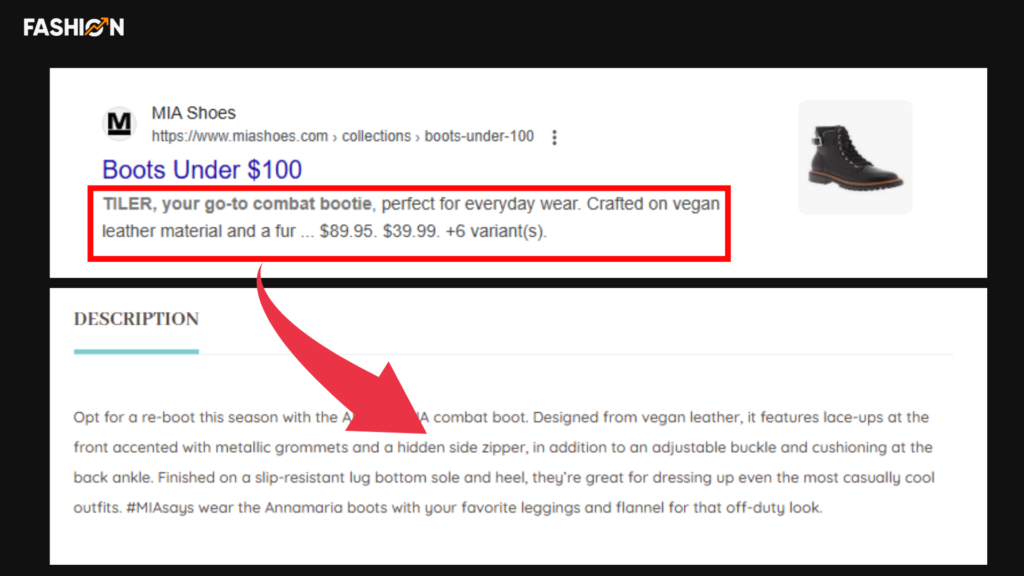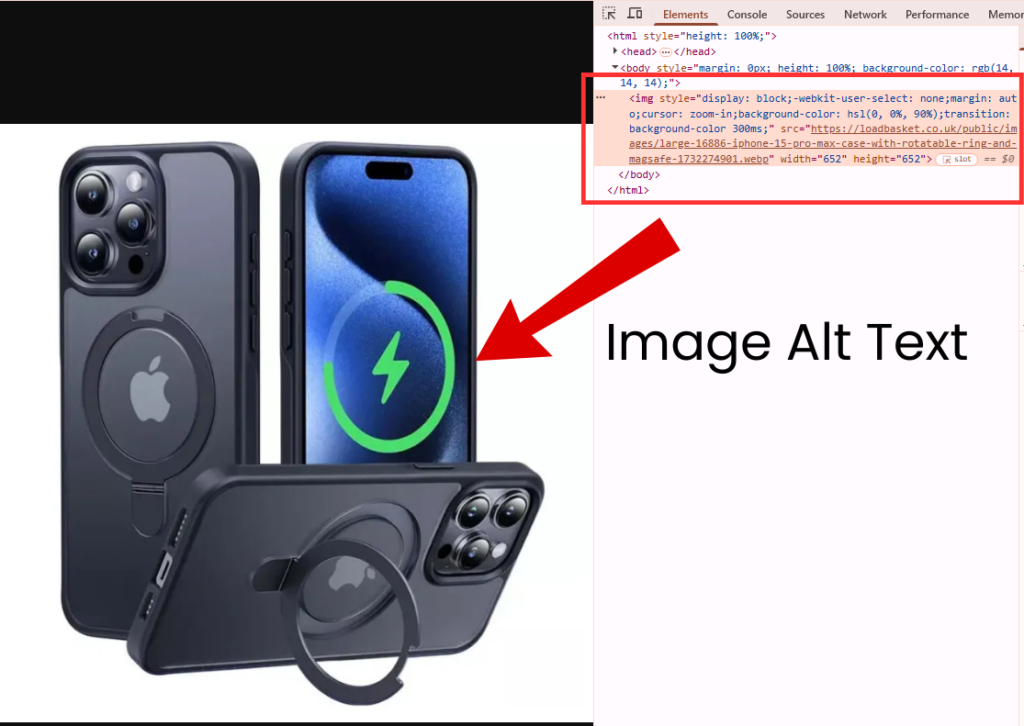Product Description SEO Is Your Sales Genie
Your product could be the world’s best product in its category…but if its description is not SEO-friendly, no one will find it…and it will be as bad as any lousy product in your category.
But the old way of writing product descriptions has evolved.
AI is booming…shoppers are smarter, and search engines are stricter. And you know that ad costs are rising daily, and your ideal buyers have short attention spans.
So due to all of this, you need to be smart and efficient with writing product descriptions that bring you organic visitors.
We have written over 2700 product descriptions in the past 6 months and know what works and what does not.
This guide will show you how to write product descriptions that rank higher and drive sales…whether you’re selling on Shopify, Amazon, Etsy, or your own fashion site.
Lessgo.
Understand Your Product Buyer Persona & Search Intent
Before writing, you need to know who you’re selling to. Define your ideal customer. Are they young professionals seeking trendy outfits? Eco-conscious buyers searching for sustainable materials? Budget shoppers hunting deals, or luxury lovers chasing exclusivity?
Next, understand their search intent. Are they:
- Informational? (e.g., “How to style a wrap dress”)
- Transactional? (e.g., “Buy vegan leather boots under $100”)
- Navigational? (e.g., “Zara linen pants”)
Someone searching for “vegan leather boots under $100” is ready to buy. Your description should highlight price, material, and ethical appeal.

Use Shopify/Amazon/Etsy analytics, Google Search Console, and keyword tools like Ubersuggest or Ahrefs. Find which search terms drive traffic and conversions.
REMEMBER that Fashion is emotional. Highlight how the product makes them feel (confident, elegant, edgy) not just its features.
Find the Right Keywords for Your Fashion Products
Once you’re done with defining the buyer persona and their search intent, now is the time to find the right keywords.
Keywords help your products get found. Use both short-tail and long-tail keywords.
- Short-tail: Broad terms like “black dress.”
- Long-tail: Specific terms like “black midi dress for cocktail parties.”
Long-tail keywords attract buyers closer to purchasing. They also have lower competition and higher conversion rates.
Use Google Keyword Planner/Ahrefs/SEMrush/Ubersuggest to help you find the keywords.

You can also use Amazon and Etsy’s auto-suggest feature (type in a product and see what
Here are the best places to place the keywords in your product description;
- Product title
- First 100 words of your description
- Bullet points (if applicable)
- Meta descriptions (Shopify, WooCommerce)
- Image alt text (describe the product clearly)
Avoid keyword stuffing. It makes descriptions hard to read. Place keywords naturally in sentences.
Use semantic keywords—words related to your primary keyword. For example, if maxi dress is the primary keyword, you can include flowy evening gown or boho summer dress as semantic keywords.
Optimize for voice search. Include natural-sounding queries like “What’s the best breathable fabric dress for summer?”
READ: Why Fashion Brands Need Local SEO To Outrank Competitors in 2025?
Write High-Converting, SEO-Friendly Product Titles
Your product title is one of the first things search engines and shoppers see. It affects both rankings and click-through rates. A well-optimized title helps your product get found and encourages clicks on Shopify, Amazon, Etsy, and Google Shopping.
Follow this simple formula:
[Main keyword] + [Unique Feature] + [Use Case or Occasion]
Example:
Women’s Organic Cotton Summer Dress – Lightweight & Breathable for Beachwear
This title includes:
- Main keyword: Women’s Organic Cotton Summer Dress
- Unique feature: Lightweight & Breathable
- Use case: Beachwear
Be specific with the product details. Mention the material, color, size, or occasion if relevant. Keep titles concise. Aim for 60-80 characters. Shorter titles display better on mobile and desktop.
If you’re selling on Amazon, adding your brand name increases trust and credibility. For example:
“Levi’s Men’s 511 Slim Fit Jeans – Stretch Denim for Everyday Wear”
Strong titles make it easier for search engines to understand your product and for shoppers to click through.
Read: 5 Local SEO Strategies Every Boutique Owner Should Know
Write Persuasive Product Descriptions That Sell + Rank
A product description should do more than describe—it should sell. Start with benefits, not just features. Tell shoppers how the product improves their life.
Example:
“Feel elegant and confident in this flowy linen blouse that keeps you cool all day.”
Use sensory words to describe texture, fit, and movement. Make readers imagine how the product looks and feels:
“Soft to the touch”
“Drapes beautifully over your frame”
“Stretchy and supportive for all-day comfort”
Structure your product description properly:
- Start with a short paragraph introducing the product and its key benefit.
- Use bullet points for features like materials, sizes, care instructions, and fit.
- If your platform allows, use H2 or H3 headings to break up text.
- Incorporate storytelling to create an emotional connection.
Place your main keyword in the first sentence. And use related terms (semantic keywords) naturally throughout. Don’t forget to add fit recommendations.
For example:
“Model is 5’8” and wears a Small. Fits true to size.”
Consumers care about sustainability. Include ethical production notes.
For example:
“Made from 100% organic cotton. Ethically sourced and produced with fair labor practices.”
A well-written product description builds trust, ranks higher, and drives more sales.
Optimize Images & Alt Text for Better SEO and User Experience
In fashion e-commerce, images sell products. High-quality visuals increase engagement and reduce bounce rates. But pictures also offer SEO opportunities you can’t ignore.

Start by naming your image files correctly. Use descriptive, keyword-rich names.
For example:
black-midi-dress-cocktail.jpg
Next, write clear and specific alt text. Alt text helps search engines understand your images and improves accessibility.
For example:
Woman wearing a black midi cocktail dress with lace details.
It matters because:
- Google Image Search can drive additional traffic.
- Accessibility improves user experience and meets compliance standards.
Use WebP format for faster load times without sacrificing quality. This improves page speed, a ranking factor. Visual search is on the rise. Platforms like Google Lens and Pinterest Lens rely on well-optimized images and alt text to deliver accurate results. Make your products easy to find visually.
READ: Top 10 Retail SEO Trends to Consider in 2025 (Expert Research-Based)
Use Customer Reviews and UGC (User-Generated Content) for SEO
Customer reviews are powerful for SEO. They add fresh, relevant content to your product pages. Reviews often include natural keywords that help boost rankings over time.
User-generated content (UGC), like customer photos and videos, builds trust. Shoppers want to see how products look in real life—on different body types, in different settings. This can increase conversions significantly.
Encourage reviews and UGC by:
- Send post-purchase emails asking for feedback.
- Offer discount codes or small incentives in exchange for reviews or photos.
Display reviews and UGC strategically:
- Place them below your product description or in a dedicated review section.
- Highlight customer feedback on fit, quality, and overall satisfaction.
Add Schema markup for reviews. This can help your pages earn rich snippets in search results. Platforms like Shopify and WooCommerce offer plugins that make Schema easy to implement.
Shoppers trust peer validation more than brand claims. Authentic reviews and photos can make or break a sale.
Take Care Technical SEO for Product Pages (For Quick Wins)
Technical SEO makes sure your product pages are easy for search engines—and shoppers—to find and use. Start with fast-loading pages. Google prioritizes speed, and slow pages hurt rankings and sales. Use compressed images (WebP) and fast hosting.

Next, ensure mobile-first optimization. Most shoppers browse on mobile. Use responsive Shopify themes or ensure your custom site works flawlessly on phones and tablets.
Your URL structure should be clean and keyword-friendly.
For example:
/collections/dresses/products/black-midi-dress
Add internal links to related products and categories. This helps users browse more and increases page authority.
Use Schema Markup to display prices, stock status, and reviews in search results. Shopify apps and JSON-LD generators make this easy.
Regularly track page performance in Google Search Console and GA4 to spot and fix issues quickly.
Don’t Sleep on Your Product Description SEO
The fashion e-commerce space isn’t slowing down, nor are your competitors. If your product descriptions still sound generic or flat, now’s the time to level up. Every word on your product page can build trust, spark desire, and drive action. The brands winning in 2025 are the ones that write for humans first and algorithms second.
So, take a closer look at your bestsellers. What story are they telling? And more importantly—who’s listening?
Ready to turn product pages into your best salespeople? Start rewriting today. Your future customers are already searching. Ensure they find you…and feel confident enough to click “Add to Cart.”
If you want our help…please feel free to contact us.

